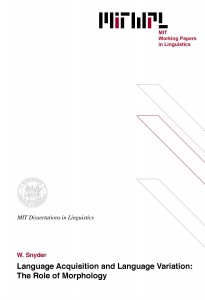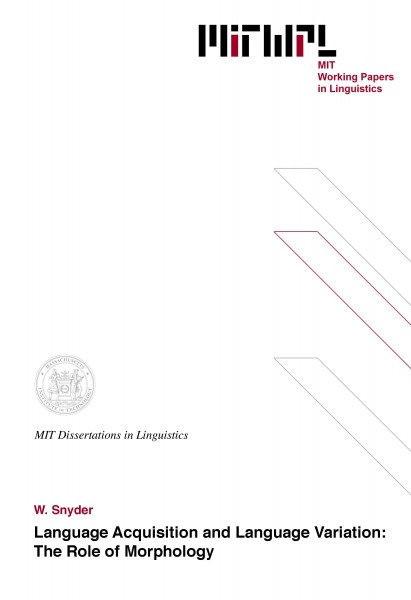Language Acquisition and Language Variation: The Role of Morphology
W. Snyder, 1995
Evidence from comparative syntax is combined with evidence from child language acquisition to address foundational questions about the mental representation of language-particular syntactic knowledge. Three principal models of language-particular (parametric) knowledge are evaluated: (1) the "switch-box" model, in which the values of parameters are highly abstract and have widespread grammatical consequences independent of any particular lexical item; (2) the "lexical" model, in which points of variation are expressed in terms of the morphosyntactic properties of specific lexical items, especially functional heads; and (3) the "morphological" model, in which points of syntactic variation are determined by overt characteristics of morphology.
An investigation of the morphosyntax of number and degree expressions with noun and adjective phrases indicates that the point of variation determining the syntax of number expressions with NPs also determines the syntax of degree expressions with APs. Yet, cross-linguistically, the syntax of number and degree is shown to be independent of any overt morphology. Hence, even where a syntactic parameter can readily be tied to the morphosyntax of functional heads, overt morphology does not exert any necessary effect on the setting of the parameter. A related, acquisitional investigation of the phenomenon of Noun-drop in Spanish is also reported, though the results are less clear-cut.
In one domain, however, an important link is demonstrated between parametric syntax and overt morphology. Languages are shown to permit complex predicate constructions of the type exemplified by the English resultative, if and only if they freely permit the formation of novel Noun-Noun compounds. Moreover, the age when a child acquiring English first produces complex predicates such as verb-particle combinations, is predicted with remarkable accuracy by the age when the child first produces novel Noun-Noun compounds. The complex-predicate/compounding connection is argued to follow from properties of the syntax-semantics interface; a formalization is provided within a neo-Davidsonian framework. The relevant parameter is shown to be independent of any single lexical item. The findings from complex predicates and number/degree expressions, taken together, indicate that points of parameter variation in syntax are not necessarily tied either to overt morphology or to a specific lexical item.
Thesis Supervisor: Kenneth Wexler
Title: Professor of Psychology and Linguistics
<br/>
Table of Contents
1 Introduction: knowledge of language 13
1.1 Preview 13
1.2 Issues in grammatical representation 15
1.3 Methodological perspective 18
1.4 Theoretical perspective 22
2 Complex predicates and morphological compounds 25
2.1 Introduction 25
2.2 A cross-linguistic survey of resultatives and N-N compounds 28
2.3 Children"s acquisition of complex predicates and N-N compounds 38
2.4 Explaining the association of complex predicates and
compounding 45
2.5 Theoretical implications for syntax, morphology, and acquisition 59
2.6 Addendum: Korean 63
3 Noun-drop and morphological paradigms 68
3.1 Introduction 68
3.2 Case-study: Juan 77
3.3 English-speaking controls: Adam and Eve 87
3.4 Conclusions 92
4 The morphosyntax of number and degree 97
4.1 Introduction 97
4.2 A cross-linguistic survey of number morpholofy and the syntax
of quantity 104
4.3 A cross-linguistic survey of the syntax of degree 121
4.4 Children"s acquisition of number, quantity, and degree 134
4.5 Discussion 148
5 Conclusions in Summary 152

